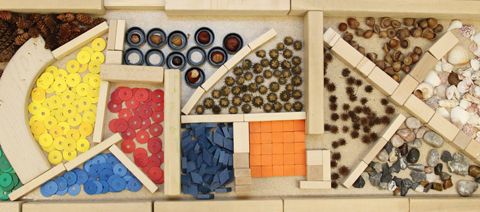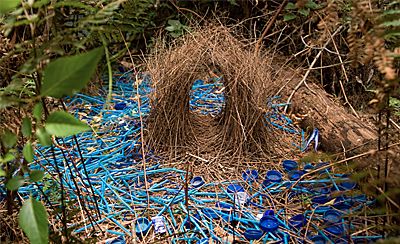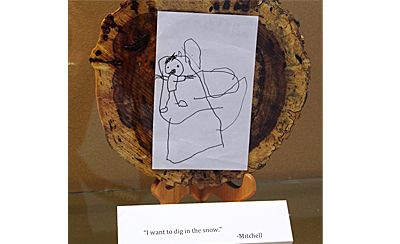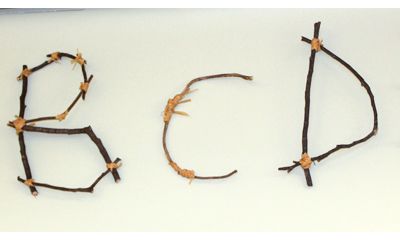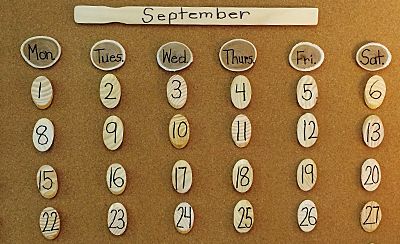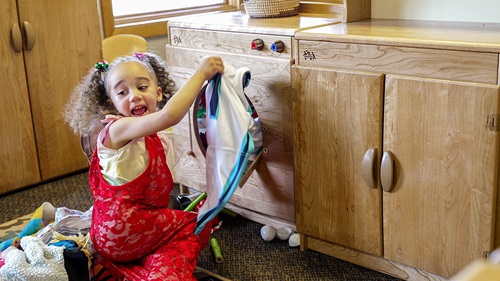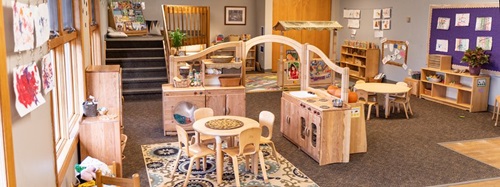Lessons from the Bowerbird
How to Create Appealing, Beautiful, and Purposeful Habitats
|
February 2015
Although a bird may seem like an unlikely role model for teachers, the bowerbird, a small native of Australia and New Zealand, has a lot to teach us about early childhood classroom design. This amazing avian artist and architect goes to extraordinary lengths to build and decorate his nest or bower. Spending countless hours searching and collecting, the male bowerbird beautifies his habitat with broken bits of colorful glass, fragments of holiday garland and tinsel, shiny gum wrappers and milk caps, pieces of plastic and metal, tiny morsels of beautiful berries, and multicolored bits of yarn and string. His collections are painstakingly arranged according to type of material and color—especially the color blue, which is a favorite of the female bowerbird.
Unlike the clutter present in many early childhood classrooms, the objects in these bowers are intentionally chosen for their value and purposefully placed. Far from institutional, each nest is a unique and artistic creation. Take a new look at your classroom through the eyes of a bowerbird and see how you can make your space more appealing, beautiful, and purposeful.
The Bower(picture from the internet)
Lesson #1: Be a curator.
Dedicated to creating a welcoming and inviting space, the male bowerbird’s reedy nest is more than a resting place; it is a beautiful habitat designed to attract the female bowerbird. The bird’s natural impulse is to value his found objects by displaying them with great care. Each object brought to the nest area is highly cherished and positioned with intentionality as would an art museum curator who hangs a beautiful oil painting in a gallery. The bowerbird is a curator.
Just as the bowerbird arranges and displays his found treasures, museum curators are also responsible for the design and arrangement of art exhibits. Curators determine how and where the priceless objects and artifacts will be displayed. They are the guardians of the artists’ work. This is an invitation for you to become a guardian and curator of children’s work. Celebrate and cherish their accomplishments as you would a fine piece of art. Display children’s work in attractive and beautiful ways. Be a bowerbird.
One way to honor children is to think critically about how you display their work. Children’s work should be displayed in ways that respect their artistic accomplishments. Prior to hanging a child’s work, a good rule of thumb is to ask this question: Would I hang this picture as it is in my home?If the answer is “no”, then it is important to ask yourself another question: What could I do to better honor this child’s work?
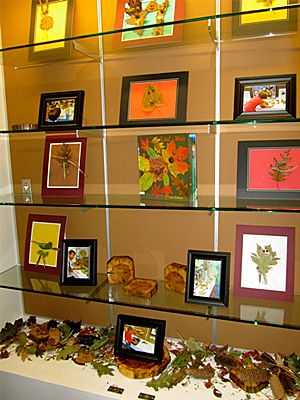
Children’s work displayed with honor.
Central Michigan University’s Child Development & Learning Lab, Mount Pleasant, MI
One technique for showing the importance of children’s work is to make it gallery-presentable prior to hanging or displaying. For example, try framing children’s artwork with similar-type frames. Perhaps you could use unique textures such as burlap, grass cloth, or fabric for matting material. Or, use different type backdrops such as woven placemats or cork squares. Exhibit children’s work in uncommon ways such as using a chair with its legs cut down for a shelf, mounting a child’s drawing on a large tree cookie, or inserting children’s work and their photographs into an old window pane that is backlit.
Displaying children’s work that is beautifully framed or exhibited recognizes and affirms their value to the artist, classroom community, and others who enter the space. Display with honor. Adopt this strategy as a fundamental approach to children’s learning environments. Be a curator. Be a bowerbird.
A child’s drawing mounted on a large tree cookie draws attention to the artist’s work.
Central Michigan University’s Child Development & Learning Lab, Mount Pleasant, MI
Lesson #2: Seek beauty and purpose.
The male bowerbird makes intentional and informed choices when selecting objects to adorn his nest. Because he knows the female bird adores the color blue, he purposefully seeks out objects of that color. Shiny and glittery objects are also carefully selected to be an important and aesthetic part of his nest. Like the bowerbird, children need beauty in their spaces. Seek beauty, collect beauty, and create islands of beauty in your environment. Be a bowerbird.
Bowerbirds’ nests are all unique. Just like early childhood classrooms, the birds’ nests comprise different objects, are individually arranged, and come in all shapes and sizes. Despite these differences, nonetheless, there is the common denominator of beauty and purpose in each bird’s nest: The male bowerbird intentionally selects beautiful objects for the nest with the purpose of attracting the female.
Make beauty and purpose your common denominator when creating spaces for young children. In order to be a bowerbird and create islands of beauty in your classroom, intentional choices must be made. Some of these choices may be uncomfortable because creating spaces of uniqueness and beauty requires you to go beyond the assumption that all classrooms need to look alike. It requires you to understand that your classroom does not need to be a replica of the room next door or look exactly like the pictures in the early childhood catalog. Being a bowerbird requires you to think beyond the ordinary.
One way to get beyond the early childhood catalog is to critically think about your classroom walls. Does the number of commercially purchased charts displayed on the wall outweigh the amount of displayed children’s work? Is there an alphabet train or color chart that stays up pretty much the entire year? Are cartoon or storybook characters hanging on your classroom walls? Are there brightly colored borders with scalloped edges around the bulletin board? Are the majority laminated? If you answered “yes” to any of these questions, it is time for you to become a bowerbird and think about alternative ways to adorn your habitat.
Lesson #3: Be finicky.
Just like the bowerbird, be finicky about what is in your classroom habitat—especially what is posted on your walls. One way to accomplish this is to de-commercialize the walls. Begin by taking everything off the classroom walls and bulletin boards. Now, like the bowerbird, intentionally and carefully select what items will or will not return to the wall using the following guidelines:
- The majority of displays on the walls should be children’s work and very few (if any) commercially purchased materials (i.e., posters, charts) or cutesy cartoon figures should be on the walls.
- Create art galleries with clusters of pictures grouped together. To create interest and variety, arrange the grouping so each picture illustrates a different type of art medium (i.e., watercolors, chalk, or collage).
- Give children opportunities to create displays. Rather than purchasing an alphabet train, for example, have children make it. Children can create their own by using sticks, pebbles, clay, and small pinecones to construct the letters.
Forget purchasing an alphabet poster.
Find some small twigs and use rubber bands or twist ties to construct the letters.
Irvine Nature Center, Owings Mills, MD
Lesson #4: Create habitats of importance.
The male bowerbird has a distinct purpose gathering objects to beautify his nest. With each carefully placed piece, the male bowerbird is sending a message to the female bird: You are important.
Look at what is hanging on your classroom walls. Have you carefully selected and placed each piece? Why are they important to be hanging in your classroom? What kinds of messages are they sending to the children? Walls filled with commercially purchased charts and posters may send messages of indifference because they hang on the wall day after day and month after month. They may send messages of boredom if children are required to review their contents on a daily basis. They may even send a message of “keep away” because children rarely are interactive with the laminated cardboard. In fact, laminated materials can create a harsh glare to children’s eyes. Children with sensory integration disorders are challenged with this type of glare and often look away. Walls filled with commercially purchased charts and posters become nothing more than visual noise. And, that noise is filled with unimportance.
Create walls of importance by taking down the laminated posters, number charts, the alphabet train, and even the commercially purchased calendar. Take down the neon-green paper backing and scalloped edge borders from the bulletin board. Replace these with authentic and child-created objects that are purposefully and intentionally placed on the walls. Tell your children: You are important. Be a bowerbird.
Instead of purchasing a laminated cardboard calendar, make your own with small tree cookies. The numbers were mounted with double stick Velcro directly onto an existing bulletin board
Beth Hillel, Northbrook, IL
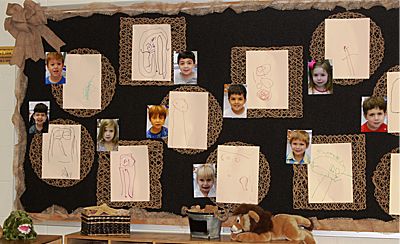
Use fabric or felt to cover the bulletin board’s background and thick ribbon or burlap to frame it. Woven place mats of different sizes and shapes draw attention to children’s faces and their work.
Saul Spielberg Preschool, St. Louis, MO
Many thanks to Sue Penix, Infant Toddler Specialist at BCCCRC in Baltimore who kindled my interest in the bowerbird’s nest building.

